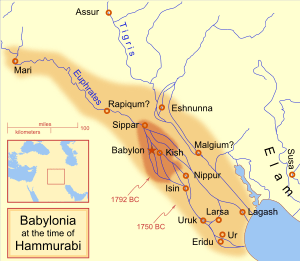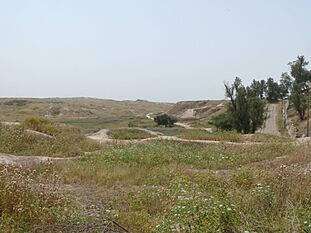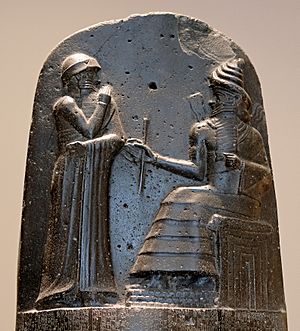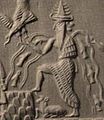Code of Hammurabi facts for kids
Quick facts for kids Code of Hammurabi |
|
 |
|
| Created | c. 1792–1750 BC (middle chronology) |
| Location |
|
| Authors | King Hammurabi of Babylon |
| Purpose | Debated: A set of laws, a record of court cases, or a guide for judges |
The Code of Hammurabi is a famous set of laws from the ancient kingdom of Babylon. It was created between 1755 and 1750 BC and is one of the oldest, most complete, and best-preserved collections of laws ever found.
The code was written in the Akkadian language on the orders of Hammurabi, the sixth king of Babylon. The main copy that we have today is carved onto a tall, black stone monument called a stele. This stele is over 2.25 meters (7.4 feet) tall.
The stele was found by archaeologists in 1901 in the ancient city of Susa (in modern-day Iran). It is now on display at the Louvre Museum in Paris.
At the very top of the stele, there is a carving of King Hammurabi receiving the laws from Shamash, the Babylonian god of justice. Below the carving, there are about 4,130 lines of text written in cuneiform, a type of wedge-shaped writing. The text includes an introduction, a conclusion, and 282 laws covering topics like family, property, and business.
The Code of Hammurabi is famous for the principle of "an eye for an eye," which means that the punishment should match the wrongdoing. It is a very important artifact that teaches us about life and justice in ancient Mesopotamia.
Who Was Hammurabi?
Hammurabi was the sixth king of the first dynasty of Babylon and ruled from 1792 to 1750 BC. He was a skilled military leader and diplomat who expanded his kingdom to control much of ancient Mesopotamia.
Besides being a powerful ruler, Hammurabi's letters show that he cared about the well-being of his people. He wanted to be seen as a just and fair king. In the introduction to his code of laws, he wrote that his goal was "to prevent the strong from oppressing the weak." He worked on many building projects and often called himself the "shepherd" of his people, meaning he wanted to protect and guide them.
The Famous Stone Stele
The most complete copy of the Code of Hammurabi is carved on a large stone monument, or stele. It was discovered in 1901 by a team of French archaeologists in the ancient city of Susa.
Historians believe the stele was originally set up in a Babylonian city, probably Sippar. About 600 years after it was made, an Elamite king named Shutruk-Nakhunte conquered the city and took the stele to Susa as a treasure of war.
The Carving at the Top
At the top of the stele is a detailed carving. It shows King Hammurabi standing respectfully before Shamash, the god of the sun and of justice. Shamash is seated on a throne and is handing Hammurabi a rod and a ring, which were symbols of power and justice.
This image was meant to show everyone that the laws were not just Hammurabi's ideas. It suggested that the laws came from the gods, and the king was chosen to enforce them on Earth.
What the Code Says
The text on the stele is divided into three parts: an introduction (prologue), the laws themselves, and a conclusion (epilogue).
The King's Introduction and Conclusion
The prologue is a poetic introduction where Hammurabi explains that the gods chose him to bring justice to Babylon. He lists his great achievements, like building temples and winning battles. He states that the purpose of the laws is to protect the weak from the strong and to make sure everyone is treated fairly.
The epilogue is the conclusion at the end of the laws. In it, Hammurabi praises his own laws and encourages future kings to follow them. He promises blessings for any ruler who respects the laws and calls down curses from the gods on anyone who tries to damage the stele or change his words.
A Look at the Laws
There are 282 laws in the code, written as "if... then..." statements. For example, "If a person does this, then this will be the consequence." The laws cover many areas of life in Babylon.
Here are some examples of the types of laws in the code:
- Fairness in Court: Laws about telling the truth. If someone accused another person of a serious wrongdoing but could not prove it, the accuser would receive a harsh punishment.
- Property Rules: Many laws dealt with theft, farming, and property damage. For example, if a person was caught stealing, they had to return what they stole and often pay a large fine.
- Business and Trade: The code set rules for merchants, builders, and boatmen. For example, one law set the daily wage for a hired worker. Another law stated that if a builder built a house that collapsed and hurt someone, the builder would be held responsible.
- Family and Home: There were laws about marriage, divorce, and adoption. These laws were meant to protect family members and make sure property was passed down correctly.
Justice in Ancient Babylon
The Code of Hammurabi gives us a good idea of what was considered fair and unfair in Babylonian society.
An Eye for an Eye
One of the most famous ideas from the code is lex talionis, a Latin phrase that means "the law of retaliation." This is often summarized as "an eye for an eye, a tooth for a tooth."
For example, Law 196 says: "If a man should blind the eye of another man, they shall blind his eye." This meant that the punishment should fit the harm that was done.
Different Rules for Different People
Justice was not the same for everyone in Babylon. The punishments depended on a person's social class. Society was divided into three main groups:
- The awilum, who were nobles or upper-class citizens.
- The mushkenum, who were commoners or free people of a lower class.
- The wardum, who were enslaved people.
If a noble hurt another noble, the punishment was often "an eye for an eye." But if a noble hurt a commoner or an enslaved person, the punishment was usually just a fine. This shows that people in the upper classes were considered more valuable in the eyes of the law.
Why Was the Code Created?
Historians are not completely sure what the main purpose of the Code of Hammurabi was. There are a few main theories:
- It was a real code of law. Some scholars think it was a set of official laws that judges in Babylon had to follow for every case.
- It was a guide for judges. Other experts believe it was more like a collection of past legal cases. It could have been used to teach judges how to make fair decisions.
- It was a monument to the king. Some historians argue that the stele was a piece of royal propaganda. By creating this monument, Hammurabi was showing everyone that he was a wise and just king who had the approval of the gods.
Even if the laws weren't followed exactly in courts, the code is still very important. It shows what the Babylonians thought was important and how they tried to create an orderly society.
The Code's Lasting Impact

The Code of Hammurabi is one of the most important legal documents in history. For over a thousand years after it was written, students in Mesopotamia copied and studied the text.
The code is often compared to other ancient laws, especially the laws given to Moses in the Bible. Both sets of laws share ideas like "an eye for an eye" and have similar rules about topics like what to do if an ox gores a person. While the laws are not identical, they show that many cultures in the ancient Near East shared common ideas about justice.
Today, Hammurabi is honored as an important lawgiver in history. A relief portrait of him is on the wall of the U.S. Capitol building, along with other famous historical figures who created laws. Replicas of the stele can be found in many places, including the headquarters of the United Nations in New York City.
Images for kids
-
A close-up of the cuneiform script on the stele. The text was written in an older style, even for that time.
See also
 In Spanish: Código de Hammurabi para niños
In Spanish: Código de Hammurabi para niños
- History of institutions in Mesopotamia








